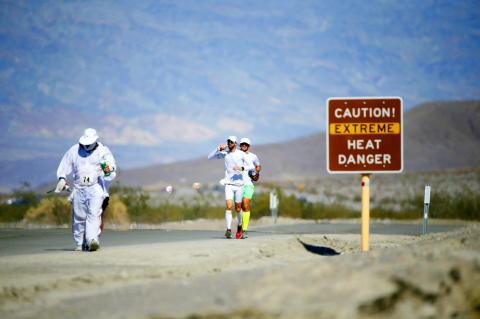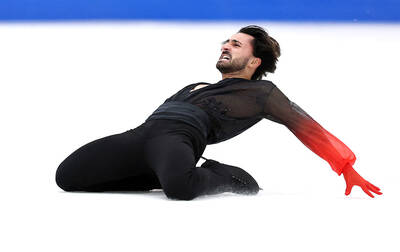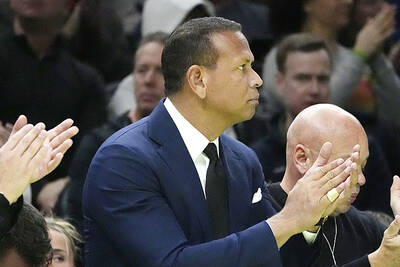Running 217km through the searing summer heat of Death Valley in California before ending the route with a cumulative gain of 15,181m to reach the slopes of Mount Whitney?
Slogging across four desert courses, each 241km long, in Chile, China, Egypt and Antarctica in what is known as the Four Deserts Grand Slam?
Racing against the clock through 75 control points in the footsteps of ancient Athenian messenger Pheidippidis, with a cut-off of 36 hours to complete the 246km Spartathlon?

Photo: Reuters
Risking dehydration, exhaustion, broken ankles, kidney failure or the need to throw in the towel and give up — all possible reasons for an athlete to abort the grueling challenge of an ultramarathon?
For the uninitiated, all of the above scenarios suggest a twinning of sadism with sheer lunacy. However, for the ultramarathoner, it is all about running for joy, setting personal goals and trying to overcome every obstacle faced.
“People are intrigued by the thought of someone wanting to run 100 miles [160km], or more,” experienced ultramarathoner Shannon Farar-Griefer, who has five times raced the grueling Badwater 135 across Death Valley, told reporters. “They might say: ‘What’s wrong with you that you want to run 100 miles? Were you abused, or were you a drug addict?’ We just love to run. It’s all about passion in this sport.”
“You know you’re going to hurt, you know you’re going to have a long day,” Farar-Griefer said. “That’s why people think that we are a little different from the rest, because we keep pushing our bodies. Ultras are all about learning how to be able to accept pain.”
An ultramarathon involves a combination of running and walking further than the traditional marathon of 42.2km. Though most ultras cover distances of either 80km or 160km, many are much longer.
For Connecticut-based running coach Tom Holland, an exercise physiologist and certified sports nutritionist who has competed in more than 60 marathons and 21 triathlons, ultras are all about achieving objectives.
“It’s the innate human desire to push our limits,” Holland told reporters. “I believe many people find incredible personal satisfaction in achieving these challenging goals. They run a marathon or three and then have a need to push their bodies even further, both physically as well as mentally. Pushing through periods of incredible discomfort and coming out on the other side is extremely empowering.”
Holland is a veteran of several ultras, including the Run to the Sun, a 58km journey to the 3,055km-high summit of Haleakala on the island of Maui, and he regards the ultra challenge as a metaphor for life.
“You realize that no matter how bad you think things are at the time, you are strong enough to push through them and things will always get better,” he said.
Australian Samantha Gash, the first woman to complete the Four Deserts Grand Slam in a calendar year, said that ultramarathoners share a burning desire to be the best they can be while often competing well outside their comfort zones.
“The people who finish are not the most physically fit, but the ones that are mentally strong, those who don’t entertain the possibility of not finishing,” she said.
Gash, who is featured in a documentary released last year called Desert Runners, which chronicles the Four Deserts Grand Slam, gained a massive jolt of self-belief after her pioneering accomplishments in Chile, China, Egypt and Antarctica.
“Being [previously] a nobody in the world of ultra running, if I could do something of this size and scale, it makes you feel that anything’s possible,” she said of her success in the Four Deserts Grand Slam.
“There were moments when I wondered what I was doing, when I was so dehydrated it hurt. I felt new depths of pain, but I really never let myself contemplate giving up,” said Gash, who had to contend with heat, cold, dehydration and extreme fatigue in some of the world’s most hostile environments while running with supplies strapped to her back.
Farar-Griefer, a 53-year-old mother of three who lives in Hidden Hills, California, and took up long-distance running at the age of 39, has no doubt about her most brutal ultra experience.
“The 292-mile Death Valley Badwater double, by far,” Farar-Griefer said, referring to her feat in becoming the first female to complete the “double” by finishing the 135 ultra, then making it to the summit of Mount Whitney before returning to the race’s original start.
“All the other runners finished at the portals of Mount Whitney, but I continued on and I summited Mount Whitney and then I ran back. It was 130o [54oC] on the way back,” she said. “At mile 270, I got an edema really bad. I was swollen, I couldn’t pee. It was scary because you could go into total renal failure at that point. Thank God I had a very experienced crew.”
“It’s a sport where you have to be able to endure pain and you have to be comfortable stepping out of your comfort zone,” she said. “It’s a constant mind battle. I love it.”

France’s Kevin Aymoz snatched the men’s title at Skate America on Saturday, winning his first grand prix title with a battling free skate, while short program leader Kazuki Tomono faltered. It was an emotional triumph for Aymoz, who made his grand prix level debut in 2017, with seven prior podium finishes, but no gold. He had struggled with a painful foot injury since a disappointing 10th-place finish at Skate Canada last month. “It was so difficult,” the 28-year-old said. “After Skate Canada I wanted to give up so much and today I’m here and it’s so beautiful to be with my friends competing

Nigeria’s soccer coach has accused the Democratic Republic of the Congo (DR Congo) of practicing “voodoo” after his squad’s hopes of qualifying for next year’s FIFA World Cup ended in a penalty shoot-out loss in the African playoff final. DR Congo and Nigeria drew 1-1 after extra-time in the tie in Rabat, Morocco, on Sunday and the central Africans won 4-3 on penalties to book a place in inter-confederation playoffs in Mexico in March next year. In his post-match remarks to journalists, coach Eric Chelle said a member of the DR Congo team “did some voodoo, every time, every time, every time.” “That

A start-up’s entry into prediction market trading is raising fresh questions about the involvement of NBA owners in sports betting. The start-up, Mojo Interactive Inc, was cofounded by Alex Rodriguez and Marc Lore, the owners of the NBA’s Minnesota Timberwolves and the WNBA’s Lynx. Mojo has started trading on the outcome of sports games on the prediction market exchange Kalshi, an arrangement that is now being reviewed by the NBA. Mojo began trading event contracts tied to sports during the NFL season this fall, according to Mojo CEO Vinit Bharara. Mojo has yet to trade on any NBA games, Bharara said in

Australian cyclist Paige Greco, a Paralympic gold medalist, has died. She was 28. A joint statement by the Australian Paralympic Committee and Cycling Australia said that Greco “passed away in her Adelaide home after experiencing a sudden medical episode” on Sunday. “Paige meant everything to us,” her mother Natalie Greco said. “Her kindness, her determination and her warmth touched our family every single day. She brought so much joy and pride into our lives, and the pain of her passing is something we will carry forever, “ Natalie Greco said. “While we are devastated by her loss, we are incredibly proud of the person she